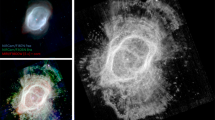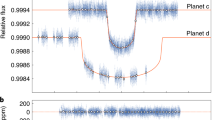Abstract
With its imaged debris disk of dust, its evaporating exocomets, and an imaged giant planet, the young (~23 Myr) β Pictoris system is a unique proxy for detailed studies of planet formation processes as well as planet–disk interactions. Here, we study ten years of European Southern Observatory/High Accuracy Radial Velocity Planet Searcher (HARPS) high-resolution spectroscopic data of β Pictoris. After removing the radial velocity (RV) signals arising from the δ Scuti pulsations of the star, a ~1,200-d periodic signal remains, which, within our current knowledge, we can only attribute to a second planet in the system. The β Pic c mass is about nine times the mass of Jupiter; it orbits at ~2.7 au on an eccentric (e ~ 0.24) orbit. More RV data are needed to obtain more precise estimates of the properties of β Pic c. The current modelling of the planet’s properties and the dynamic of the whole system has to be reinvestigated in light of this detection.
This is a preview of subscription content, access via your institution
Access options
Access Nature and 54 other Nature Portfolio journals
Get Nature+, our best-value online-access subscription
$29.99 / 30 days
cancel any time
Subscribe to this journal
Receive 12 digital issues and online access to articles
$119.00 per year
only $9.92 per issue
Buy this article
- Purchase on Springer Link
- Instant access to full article PDF
Prices may be subject to local taxes which are calculated during checkout




Similar content being viewed by others
Data availability
The HARPS spectra are available in the ESO archive, and the measured RV data are given in Supplementary Table 1.
Code availability
The codes used for this paper are available from the corresponding author upon reasonable request.
References
Baruteau, C., Bai, X., Mordasini, C. & Mollière, P. Formation, orbital and internal evolutions of young planetary systems. Space Sci. Rev. 205, 77–124 (2016).
Smith, B. A. & Terrile, R. J. A circumstellar disk around β Pictoris. Science 226, 1421–1424 (1984).
Augereau, J. C., Nelson, R. P., Lagrange, A.-M., Papaloizou, J. C. B. & Mouillet, D. Dynamical modeling of large-scale asymmetries in the β Pictoris dust disk. Astron. Astrophys. 370, 447–455 (2001).
Dent, W. et al. Molecular gas clumps from the destruction of icy bodies in the β Pictoris debris disk. Science 383, 1490–1492 (2014).
Kiefer, F. et al. Two families of exocomets in the β Pictoris system. Nature 514, 462–464 (2014).
Lagrange, A.-M. A probable giant planet imaged in the β Pictoris disk. VLT/NaCo deep L′-band imaging. Astron. Astrophys. 493, L21–L25 (2009).
Lagrange, A.-M. et al. A giant planet imaged in the disk of the young star β Pictoris. Science 328, 57–59 (2010).
Mouillet, D., Larwood, J. D., Papaloizou, J. C. B. & Lagrange, A.-M. A planet on an inclined orbit as an explanation of the warp in the β Pictoris disc. Mon. Not. R. Astron. Soc. 292, 896–904 (1997).
Nesvold, E., Kuchner, M. J. & SMACK, A. Model of colliding planetesimals in the β Pictoris debris disk. Astrophys. J. 798, 83–100 (2015).
Beust, H. & Morbidelli, A. Falling evaporating bodies as a clue to outline the structure of the β Pictoris young planetary system. Icarus 143, 170–188 (2000).
Telesco, C. M. et al. Mid-infrared images of β Pictoris and the possible role of planetesimal collisions in the central disk. Nature 433, 133–136 (2005).
Okamoto, Y. K. et al. An early extrasolar planetary system revealed by planetesimal belts in β Pictoris. Nature 431, 660–662 (2004).
Wahhaj, Z. et al. The inner rings of β Pictoris. Astrophys. J. 584, L27–L32 (2003).
Lagage, P. O. & Pantin, E. Dust depletion in the inner disk of β Pictoris as a possible indicator of planets. Nature 369, 628–630 (1994).
Lagrange, A.-M. et al. Full exploration of the giant planet population around β Pictoris. Astron. Astrophys. 612, 108–112 (2018).
Lagrange, A.-M. et al. Constraints on planets around β Pic with Harps radial velocity data. Astron. Astrophys. 542, A18–A23 (2012).
Bonnefoy, M. et al. Physical and orbital properties of β Pictoris b. Astron. Astrophys. 567, L9–L14 (2014).
Koen, C. δ Scuti pulsations in β Pictoris. Mon. Not. R. Astron. Soc. 341, 1385–1387 (2003).
Koen, C. et al. Pulsations in β Pictoris. Mon. Not. R. Astron. Soc. 344, 1250–1256 (2003).
Mekarnia, D. et al. The δ Scuti pulsations of β Pictoris as observed by ASTEP from Antarctica. Astron. Astrophys. 608, L6–L10 (2017).
Crifo, F., Vidal-Madjar, A., Lallement, R., Ferlet, R. & Gerbaldi, M. β Pictoris revisited by Hipparcos. Star properties. Astron. Astrophys. 320, L29–L32 (1997).
Lagrange, A.-M. et al. β Pictoris b post conjunction detection with VLT/SPHERE. Astron. Astrophys. 621, L8–L14 (2019).
Snellen, I. A. G. & Brown, A. G. A. The mass of the young planet β Pictoris b through the astrometric motion of its host star. Nat. Astron. 2, 883–886 (2018).
Dupuy, T., Brandt, T. D., Kratter, K. M. & Bowler, B. P. A model-independent mass and moderate eccentricity for β Pic b. Astrophys. J. 871, L4–L9 (2019).
Marois, C. et al. Direct imaging of multiple planets orbiting the star HR 8799. Science 322, 1348–1352 (2008).
Marois, C., Zuckerman, B., Konopacky, Q. M., Macintosh, B. & Barman, T. Images of a fourth planet orbiting HR 8799. Nature 468, 1080–1083 (2010).
Kennedy, G. M. & Kenyon, S. J. Planet formation around stars of various masses: the snow line and the frequency of giant planets. Astrophys. J. 673, 502–512 (2008).
Lagrange, A.-M. et al. The position of β Pictoris b position relative to the debris disk. Astron. Astrophys. 546, 38–51 (2012).
Fortney, J. J., Marley, M. S., Saumon, D. & Lodders, K. Synthetic spectra and colors of young giant planet atmospheres: effects of initial conditions and atmospheric metallicity. Astrophys. J. 683, 1104–1116 (2008).
Galland, F. et al. Extrasolar planets and brown dwarfs around A–F type stars. I. Performances of radial velocity measurements, first analyses of variations. Astron. Astrophys. 443, 337–345 (2005).
Anglada-Escudé, G. & Butler, P. R. The HARPS-TERRA Project. I. Description of the algorithms, performance, and new measurements on a few remarkable stars observed by HARPS. Astrophys. J. Suppl. 200, 15–34 (2012).
Locurto, G. et al. HARPS gets new fibres after 12 years of operation. Messenger 162, 9–15 (2015).
Bradley, P. A. et al. Analysis of γ Doradus and δ Scuti stars observed by Kepler. Astron. J. 149, 68–81 (2015).
Beust, H. Symplectic integration of hierarchical stellar systems. Astron. Astrophys. 400, 1129–1144 (2003).
Beust, H. & Morbidelli, A. Mean-motion resonances as a source for infalling comets toward β Pictoris. Icarus 120, 358–370 (1996).
Thebault, P. & Beust, H. Falling evaporating bodies in the β Pictoris system. Resonance refilling and long term duration of the phenomenon. Astron. Astrophys. 376, 621–640 (2001).
Acknowledgements
This work has been supported by grants from the Agence Nationale de la Recherche (ANR-14-CE33–0018) and the French Labex OSUG@2020 (Investissements d’avenir—ANR10 LABX56). A.Z. was supported by CONICYT grant no. 2117053. A.-M.L. thanks F. Forbes, K. Zwincks, A. Lecavelier, J. Pepper, P. Kervella and J. C. B. Papaloizou for discussions. T.G., D.M., L.A. and F.-X.S. acknowledge support from Idex UCAJEDI (ANR-15-IDEX-01) and IPEV.
Author information
Authors and Affiliations
Contributions
A.-M.L. led the monitoring of the variations, the data reduction, the analysis and interpretation of the data, and the paper writing. N.M., P.R., M.K. and F.G. participated to the data fitting and analysis. E.C., E.M., L.B. and F.-X.S. brought their expertise in stellar variability. H.B. provided analysis of the dynamical stability of the system. T.G., D.M. and L.A. brought expertise on β Pictoris photometric variability. P.A.W. and F.K. brought expertise on β Pictoris spectroscopic variability. M.B., S.B., A.G., J.L.-B., B.P., D.P.I., L.R. and A.Z.S. participated in the observations.
Corresponding author
Ethics declarations
Competing interests
The authors declare no competing interests.
Additional information
Publisher’s note: Springer Nature remains neutral with regard to jurisdictional claims in published maps and institutional affiliations.
Supplementary information
Rights and permissions
About this article
Cite this article
Lagrange, AM., Meunier, N., Rubini, P. et al. Evidence for an additional planet in the β Pictoris system. Nat Astron 3, 1135–1142 (2019). https://doi.org/10.1038/s41550-019-0857-1
Received:
Accepted:
Published:
Issue Date:
DOI: https://doi.org/10.1038/s41550-019-0857-1
This article is cited by
-
Exocomets size distribution in the \(\beta\) Pictoris planetary system
Scientific Reports (2022)
-
Detecting life outside our solar system with a large high-contrast-imaging mission
Experimental Astronomy (2022)
-
A system of super Jupiters
Nature Astronomy (2019)
-
Dispersed Matter Planet Project discoveries of ablating planets orbiting nearby bright stars
Nature Astronomy (2019)



